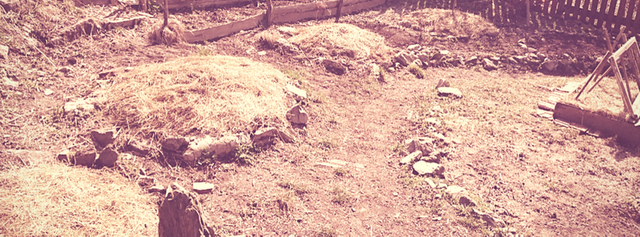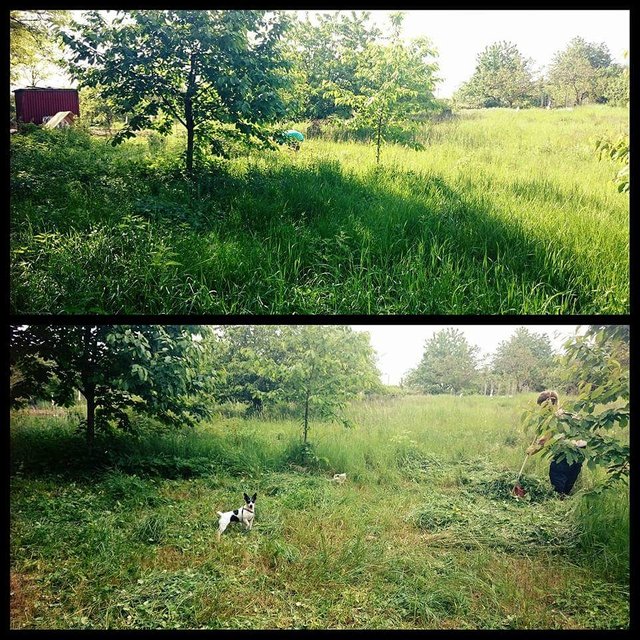Build Your Own Garden - Daily Permaculture For Life
Imagine a place which provides you with work, goals, yields, revenues and relax.
Imagine a place where you can spend your workday and be connected with soil.
Actually, it is not so far and you can now be a part of it.
What is Permaculture?
Permaculture is simply permanent culture. This article is going to talk about how you can actually get the impulse and start, this is not a permaculture introductory article - you can read it for example here
Reason why to start thinking in permacultural principles
You are on steemit, a network of innovative people. Pretty high chance you care.
There is a lot of phrases related and connected - environmental responsibility, sustainability, green architecture, renewable energy, blockchain, ...
Actually, you already have your own reason, just try to find it.
Build a Garden
A small introduction might help to answer a reason why this article.
Easiest way is to read more about Greenwayoflife on Patreon to see the whole story or watch a short video.

In few words, we are a couple with a positive experience, some knowledge and - motives to live in balance with nature throughout our lives - from touch with soil to good business with positive impact. Now, you can stick with us for some time and help, watch & get inspired. We are going to build a permaculture garden in a local colony and share all the knowledge. More milestones are available on our Patreon page. But one thing is clear - we are going to help build intensive systems on small acreages.
Why to build an edible, permaculture garden?
Please allow few points.
- Increases food self-sufficiency
- Decreases your negative footprint
- Provides positive habits
- Can give you a job or at least side income
- Allows your body and mind to rejuvenate
- What else is missing? Tell us in comments!
How to start next week?
First off - you do not need a big land. Even a very small acreages can give you large opportunity. Thanks to several techniques, you will be able to grow an abundant amounts of food and have leftovers you can use to - donate food or make money.
You even do not need to own a lot.
The best way how to start is to find a local garden colony in your town. If you are in rural location, I bet you already have at least your own small garden - or somebody else does have it in your neighborhood. Well, you do not own the place, but you can start here with some positive production and move forwards later. There are even "mobile gardens", usually made in cities on public places or greyfields where the soil is destroyed or hidden under concrete.
These utilize stacking in space - vertical gardens - raised beds, bags, pots, tubes and many more things you can get for free - in order to be repurposes, reused, upcycled.
The cost of such a small acreage lot is affordable - and - gives you low initial upcost.
For example, we rented 400sqm for less than $100 per year. What a wonderful price tag we got.
On 400 sqm, you can have really great yields, if you care about the soil, space, time, plants and yourself.
How to find the best place for my garden?
This is a bit more tricky then you might think. First off, a man does have to learn how to observe a nature.
There will be a whole series of article related to this topic - lot analysis.
So just for now to start off the topic, you are interested in:
Geographical Information Systems
GIS systems with available GIS layers can help you a lot to find out more information about your lot - including history. It is really different if your lot was a meadow, forest or recultivated grayfield 50 years ago. GIS system will also help you have accurate, 1:1 lot map. You can use this later for design process.
History and Facts
You can simply go to your local library and find historical information about location you are interested in.
You can ask people who already have gardens here - what is the soil here? How it is with water?
Sectors
Sectors help you to analyze the reality of particular lot and gives you an overview about place you are present in.
Few sectors to learn more about follows.
Sun
It is crucial to find out how the sun is present on your lot. Sun orientation, elevation, sunny and shadowy places. Summer sun, Winter sun. Nowadays, you can use yourself as the measure tool - observe, or technology - sun maps, calculators (used also for sun energy) or special tools to get results like the image below.
This is real sun tracking - on a lot, you create GIS points if you have the tools for it, and then you use the fish eye camera hardware and special SW to generate image for each point on your GIS map.
The software will generate sun track visualizations for summer and winter. After days of hard work, you have a comprehensive awareness about which zones are perfect for your structures - and it works for the complete design - your house, solar panels, greenhouse, but also a pond which needs rather shadow if it is not deep enough to keep cold enough.
As you can see, this photo was taken in winter - so you see the sun track instead of trees in full growth. This can also help you to decide which tree you will have to chop and which you can keep - in this case, the lot was inside the forest - so it was crucial to perform such a tracking. Over 60 points were tracked on a lot sized at about 3,600 sqm.

But for simple start of the first season, it is just enough to observe, use internet a bit and mark the sun route on your map.
OK, enough sun for now :-)
Wind
What is the main direction of wind? Where is the warm wind coming from and where is the cold wind coming from?
Knowledge of wind sectors will help you to plan the work with wind - it can be used in a clever way for polination, but it can also destroy your yields if not properly handled. Mark the directions on your map.
Cold and Warm
Are there any ground depressions where cold air can flow in? Try to find out and you will know where your plants are in risk of frost.
Humidity
Which places are rather wet all the time, while others are rather dry all the time? How the water flows? Visit the lot during and after rain to find out how the water behaves. Later, you can use this knowledge to plan the structures and work with water to retain and/or drain it. For example, a simple rain garden is pretty nice garden structure helping to slowly absorb the water. Swales are used to stop and collect the water coming down from slope.
Neighbours, Relations, Resources
It is important to know your neighbors and resources around. For example, your neighbor will not give you the extra organic waste from his lawn if you will put the toilet close to their relaxing bench. Think. Our neighbors would just collect the hay from lawn cutting and burn in - really. When we saw it, we just asked - hey, can we help you get rid of your organic matter you are going to burn? And we gave it back to our own soil - improving [quality of the soil on our lot] (https://steemit.com/garden/@neophonic/easy-soil-test-for-your-new-garden).
That is not all. But at least, you now have something to think about in the meantime we prepare next article.
Is your lot full of invasive plants with zero maintentance by a human?
No problem at all!
- What you see is succession and you will not be able to stop succession. If you want to get rid of weed, you will fight with wind mills. It is a mother nature which wants her skin to be covered, as like as you cover yourself with clothes. Instead of it, you can help the succession and use it for good - including weeds.
- You can learn more about the soil if you will learn about the plants on your lot
- Not all invasive plants are automatically bad. You can find edible ones, natural remedies, herbs and actually harvest them - Plantago Lanceolata, Urtica Dioica, Solidago, Matricaria... just the Urtica Dioica (Common Nettle) will make you a nice nettle juice for fertilization if you put it in water and protect against direct sun.
If your lot is plain, unused - do not worry, you have a green field to learn and shape it from the very start! Such a great chance to make strong bonds with soil and the place - the worst is the place, the more work you can give it and see the results!
#So, what you need to do now?
In order to start your own permaculture garden soon, you first need to find a proper lot.
Soon, more articles are about to come.
Start simple. Problem is a solution. High Weed is not an enemy, but a material for composting, mulch..
When a cowshit turns into high quality soil, the cycle is complete :-)

To-Do List
- Find out if there is a garden colony in your town, or find somebody with large lot to rent you a piece of land.
- Contact call-to-person and visit the lot. Feel it. Get more information about potential contract. Write down questions and notes about sectors. Get back to us in case of need.
- Help us to build a structured guide so we can make the guide easy to be absorbed and build more self-sufficiency gardens everywhere, together!
- Feel free to vote and suggest topics you would like to learn about and we will create a roadmap.
- If you want to be in daily touch with an inspiration and progress, you can follow us on Instagram.
- If you want to learn more, get an early access to extra content and build permaculture gardens, you can support us on Patreon.
So many things to share, so limited space. Thanks for reading this article.
###Do you like it? Follow us to stay in touch. We have already started.
####Use nature wisdom as well as latest technologies to build an intensive, off the grid gardening systems.
#####If you are interested about keywords below, we are the right match.
#####If you believe we have something to share with steemit community, you give us a positive impulse.
Permaculture, Renewables, Technology, Food Self-sufficience, Income, Work/Life Balance, Reuse, Repurpose, Upcycle, Sustainability.
This is just the start.
In one of the next articles, we will focus more on mapping,
which is crucial discipline to get a good land and start smart.
And what you can expect? Suggested techniques, hardware, software and mindset.
Toolbox for those who already made a decision.
The nation that destroys its soil destroys itself. Franklin D. Roosevelt
Sincerely,
Sue & Jake
As a city dweller, I built a spiral raised herb garden, started composting (with several neighbors tossing in there scraps as well) and planting raspberries, blackberries, and blueberry bushes in the yard. I don't have much sun and what I do have is enjoyed by my apiary. But it amazes me what each individual can do to start on their journey in permaculture. Enjoyed this post.
Exactly. We are also from city, this is why people like you are really nice proof this is a right way - urban gardening is a nice "buzzword", but the positive impact is reality. Even with limited or close-to-zero space, a wonderful things can be done. Thanks for being part and leaving a nice message. Such a spiral herb garden is a nice example of attractive and functional design, providing a different microclimate for each herb.
Excellent article and praiseworthy journey . Followed, and look forward to your future posts.
Thanks @themagus! New post is coming soon.